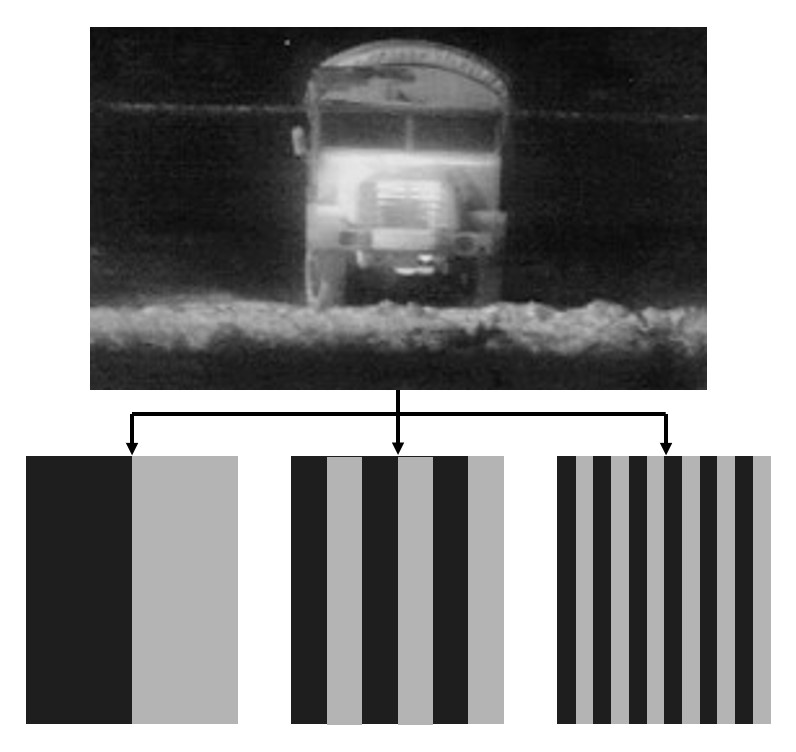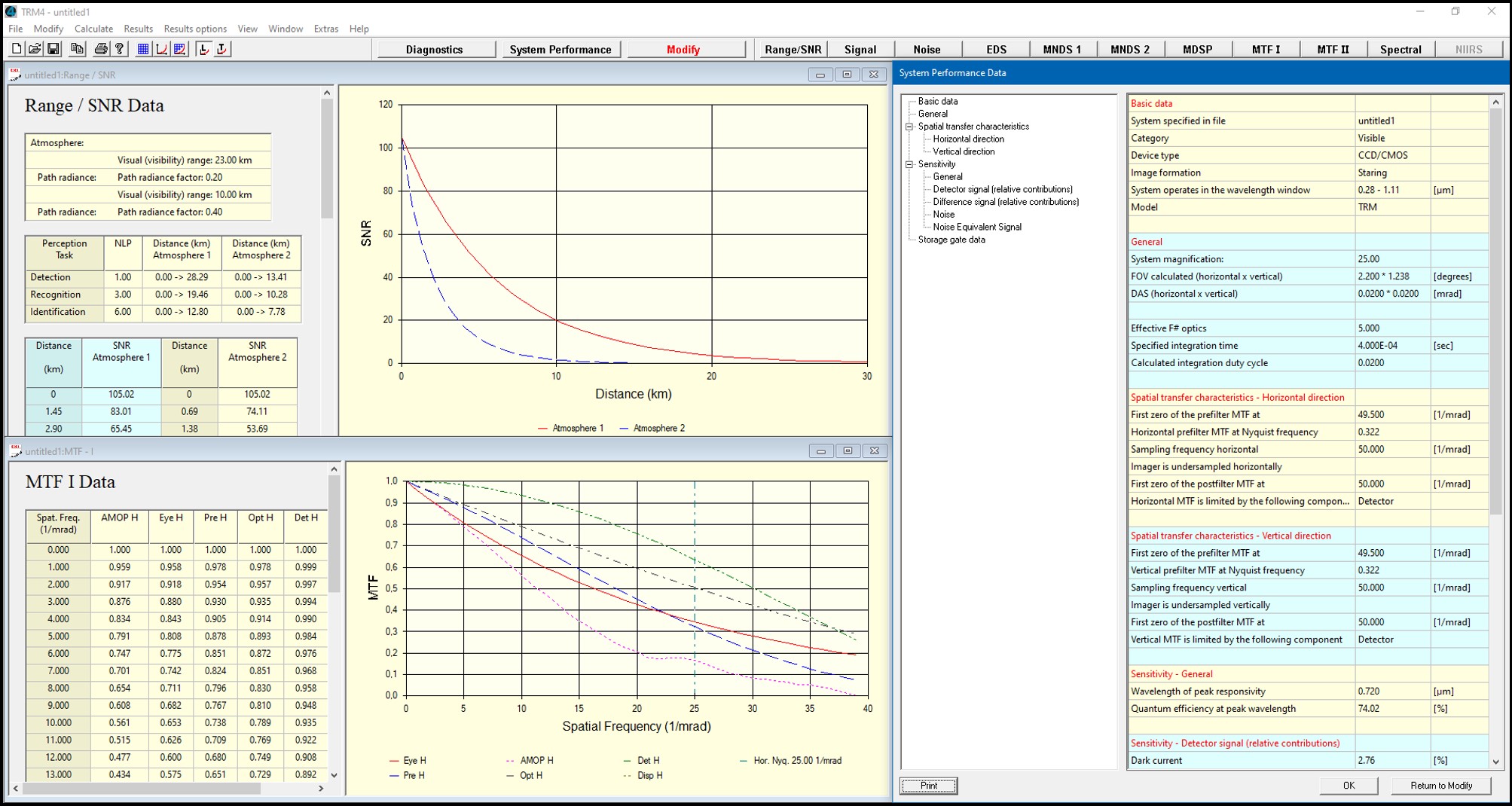Product video of the TRM4 and its functions
Range performance model TRM4
Why are models for the range performance calculation needed?
A multitude of factors must be considered in the development and use of modern electro-optical systems. Not only the characteristics of the system, but also the prevailing atmospheric conditions and the current appearance of the observed object determine the actually achievable performance.
Often, we are interested in the so-called “range performance” of the electro-optical system with regard to a particular perception task (typically detection, recognition or identification). The range performance is the maximum target-observer distance at which an observer can perform the perception task - using the electro-optical system - with a specified success probability.
For an electro-optical system that is still in the design phase, the range performance can naturally not be assessed by field or laboratory experiments. Nevertheless, it plays an important role in the selection of suitable components. But also for existing electro-optical systems, it is desirable to avoid costly experiments, for instance when analyzing the performance for a scenario that differs from the one the system was originally designed for.
Essential performance parameters of electro-optical systems are accessible through analytical models and imaging simulations. The usage of analytical models, such as TRM4, has the big advantage of obtaining results for a large number of system configurations and environmental conditions with low computational effort. However, they are based on a comparatively abstract and simplified description of the target and background as well as the human perception process.
Details on the TRM4 software and modeling approach
The TRM4 software package
The TRM software has been in continuous development for several years. While first versions were limited to modeling of thermal imagers, TRM4.v1 and later versions allow for the performance evaluation of electro-optical systems in the visible to the thermal infrared spectrum. Supported observation scenarios are, apart from the horizontal view, the flyby and approach to an object as well as the observation of objects against the sky. The user can individually specify all components along the imaging chain – starting with the scene, through the atmosphere, optics, sensor and signal processing to the display and the observer. To support the user, the TRM4 software contains a library of generic, spectrally resolved data for lighting sources, object and background reflectivities, detector sensitivities and much more.
In addition to the detection, recognition and identification ranges, a large number of other performance parameters are calculated in TRM4. They support the user in understanding the properties of the electro-optical system as well as the performance-limiting factors and components. Examples for these performance parameters are the figures of merit of the overall system MTDP (Minimum Temperature Difference Perceived) and MCP (Minimum Contrast Perceived), the MTFs (Modulation Transfer Functions) of all system components, the detected signal as well as the temporal and non-uniformity noise. As of version TRM4.v3, the user can assess the quality of aerial images for the specified imaging system by means of the calculated NIIRS values (National Imagery Interpretability Rating Scale).
Fraunhofer IOSB distributes the TRM4 software with a graphical user interface free of charge to licensees. In addition, customer-specific TRM4 versions are offered that can be integrated into user applications or used in batch mode. You can find further information at „Obtaining a license for TRM4“ and „Customized TRM4 Batch Module“.
The TRM4 modeling approach


The range performance calculation in TRM4 is based on modified Johnson criteria. Here, actual targets are replaced by equivalent bar patterns, as shown in the figure. The size, number of line pairs, and signal difference of the equivalent bar pattern depends on the target and the perception task (typically detection, recognition, and identification). The range performance is then determined as the maximum target-observer distance at which the observer can perceive the modulation of the equivalent bar pattern.
Range performance assessment in TRM4 is closely connected to the MTDP (Minimum Temperature Difference Perceived) figure of merit of thermal imagers. The MTDP is the minimum temperature difference that allows an observer to resolve a standard 4-bar pattern at given spatial frequency. Measured MTDP values may be used as input in TRM4 for the range performance calculation as well as TRM4 can predict the MTDP of thermal imagers. The comparison of measured and calculated MTDP is used at Fraunhofer IOSB to validate TRM4.
For more in-depth information on the TRM4 evaluation procedure, please refer to the infoboxes attached below.
Recent TRM versions
| Version | Publication date | New features |
| TRM4.v3 | September 2021: Official release 27 September 2021: |
+ Assessment of iCCD/iCMOS cameras, night vision goggles and direct viewing systems + Calculation of NIIRS values (National Imagery Interpretability Rating Scale) for the evaluation of aerial imaging systems +Specification and calculation of the minimum contrast perceived for imaging systems in the visible to SWIR spectrum + Modeling of targets against sky background + Interactive user help system |
| TRM4.v2 | June 2016 | + Assessment of uncooled thermal imagers |
| TRM4.v1.1 | July 2013 | + Preset data for the detection, recognition and identification criteria of handheld objects and persons + Conversion of TRM3 to TRM4 files |
| TRM4.v1 | January 2011 | + Bug fixes of the former release of TRM4.v1 |
| TRM4.v1 | August 2010 | + Introduction of the categories “VIS/NIR/SWIR” and “General” for the evaluation of imaging systems in scenarios with purely reflected radiation and reflected as well as emitted radiation, respectively. + Modeling of 3D targets and slant path observation + Detailed atmospheric model (turbulence and spectral transmissivity) |
| TRM3.v3 | December 2003 |
Outlook: ECOMOS
TRM4 is one of the core components of ECOMOS (European Computer Model for Optronic System Performance Prediction). ECOMOS is a novel evaluation approach, which in the long run should also allow to evaluate the influence of advanced digital signal processing techniques on the performance of optronic systems. More information about the European ECOMOS project can be found in the corresponding publication and the ECOMOS Homepage.
 Fraunhofer Institute of Optronics, System Technologies and Image Exploitation IOSB
Fraunhofer Institute of Optronics, System Technologies and Image Exploitation IOSB 